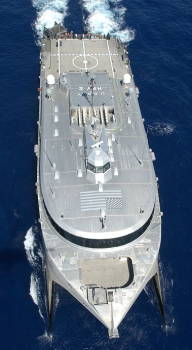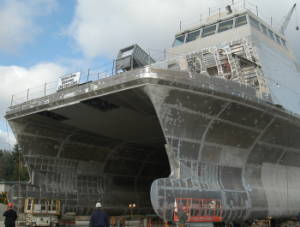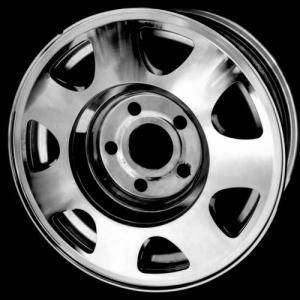
Aluminum
by Chris Woodford. Last updated: April 9, 2012.
Suppose you had to design the perfect
material—what would it be like? You'd probably want it to be plentiful and
relatively inexpensive, strong and lightweight, easy to combine with other
materials, resistant to heat and corrosion, and a
good conductor of electricity. In
short, you'd probably come up with a material like aluminum (spelled aluminium in some
countries).
It's the commonest metal in Earth's crust, the third most plentiful chemical element on our planet (only oxygen and silicon exist in greater quantity), and the second most popular metal for making things (after iron/steel). We all see and use aluminum every day without even thinking about it. Disposable drinks cans are made from it and so is cooking foil. You can find this ghostly gray-white metal in some pretty amazing places, from jet engines in airplanes to the hulls of hi-tech warships. What makes aluminum such a brilliantly useful material? Let's take a closer look!
Photo: The US Navy's High Speed Vessel (HSV) 2 Swift is a "wave-piercing" aluminum-hulled catamaran: the two prongs on the bow (front end) slice through the waves for greater speed. The lightweight aluminum hull means the ship weighs less, so it can go faster and operate closer to the shore in only 3.7 m (12 feet) of water. Photo by Michelle R. Hammond courtesy of US Navy.
What's aluminum like?
Aluminum is soft, lightweight, fire-proof and heat-resistant, easy to work into new shapes, and able to conduct electricity. It reflects light and heat very effectively and it doesn't rust. It reacts easily with other chemical elements, especially oxygen, and readily forms an outer layer of aluminum oxide if you leave it in the air. We call these things aluminum's physical and chemical properties.
Aluminum really comes into its own when you combine it with other metals to make aluminum alloys (an alloy is a metal mixed together with other elements to make a new material with improved properties—it might be stronger or it might melt at a higher temperature). A few of the metals commonly used to make aluminum alloys include boron, copper, lithium, magnesium, manganese, silicon, tin, and zinc. You mix aluminum with one or more of these depending on the job you're trying to do.
What's aluminum used for?

Pure aluminum is very soft. If you want to make something stronger but still lightweight, hard-wearing, and able to survive the high temperatures in an airplane or car engine, you mix aluminum and copper. For food packaging, you don't need anything like the same strength, but you do need a material that's easy to shape and seal. You get those qualities by alloying aluminum with magnesium. Suppose you want to carry electricity over long distances from power plants to homes and factories. You could use copper, which is generally the best conductor (carrier) of electricity, but it's heavy and expensive. Aluminum might be an option, but it doesn't carry electricity so readily. One solution is to make power cables from aluminum alloyed with boron, which conducts electricity almost as well as copper but is a great deal lighter and less droopy on hot days. Typically, aluminum alloys contain 90–99 percent aluminum.
Photo: The experimental aluminum Ford Sable car, produced in 1995, was 180 kg (400 lbs) lighter than a comparable steel-bodied car and considerably more energy efficient. Photo courtesy of US Department of Energy (DOE).
How is aluminum made?
Aluminum reacts so readily with oxygen that you never naturally find it in its pure form. Instead, compounds of aluminum exist in huge quantities in Earth's crust as an ore (raw rocky material) called bauxite. This is the common name for hydrated alumina, a substance typically made from about two thirds aluminum oxide (chemical formula Al2O3) with one third water molecules (H2O) locked into its crystal structure. Depending on where on Earth it's found, bauxite also contains a range of different impurities such as iron oxide, silicon oxide, and titanium oxide.

If you want to turn bauxite into aluminum to make useful things like cans, cooking foil, and space rockets, you've got to get rid of the impurities and the water and split the aluminum atoms from the oxygen atoms they're locked onto. So making aluminum is actually a multi-stage process.
First, you dig the bauxite from the ground, crush it up, dry it (if it contains too much water), and purify it to leave just the aluminum oxide. Then you use an electrical technique called electrolysis to split this into aluminum and oxygen. (Electrolysis is the opposite to what happens inside a battery. In a battery, you have two different metal connections inserted into a chemical compound and complete a circuit between them to generate electricity. In electrolysis, you pass electricity, via two metal connections, into a chemical compound, which then gradually splits apart into its atoms.) Once separated out, the pure aluminum is cast into blocks known as ingots, which can be worked or shaped or used as a raw material for making aluminum alloys.
Photo: Ready for recycling: These squashed mats of aluminum cans are called biscuits. They're ready to melt down and recycle. According to the Aluminum Association, nearly 70 percent of the aluminum ever mined is still in use today, thanks to effective recycling programs. It's much cheaper and more environmentally friendly to recycle used aluminum than to dig bauxite from the ground and process it: recycling saves about 95 percent of the energy that would be needed to make brand new aluminum. Photo courtesy of US Air Force.
Making usable, shiny aluminum from rocky lumps of bauxite that you've dug from the ground is a lengthy, dirty, incredibly energy-intensive process. That's why the aluminum industry is so keen on recycling things like used drink cans. It's far quicker, cheaper, and easier to melt these down and reuse them than it is to process bauxite. It's also much better for the environment because it saves a huge amount of energy.
A brief history of aluminum

Photo: Building an aluminum boat. This high-speed aluminum boat, known as the Littoral Surface Craft-Experimental (LSC-X) or X-Craft, is shown here during construction in Freeland, Washington. Photo by Jesse Praino courtesy of US Navy.
Who discovered aluminum, how, and when? Here's the story as it happened...
- 1746: German chemist Andreas Marggraf (1709–1782) realizes that alum (a natural aluminum compound used for dying textiles since ancient times) contains an unknown metal. It's aluminum, of course, but he doesn't know that.
- 1809: English chemist Sir Humphry Davy (1778–1829) names this metal "alumium" and (later) "aluminium", but is unable to separate it out.
- 1825: Danish chemist and electrical pioneer Hans Christian Øersted (1777–1851) turns aluminum oxide into aluminum chloride and then uses potassium to turn the chloride into pure aluminum. Unfortunately, he cannot repeat the trick a second time!
- 1827: German chemist Friedrich Wöhler (1800–1882) also makes a small quantity of aluminum by heating aluminum oxide with potassium metal.
- 1855: French chemist Henri Sainte-Claire Deville (1818–1881) uses sodium to separate out aluminum. Since sodium is cheaper and easier to obtain than potassium, Deville is able to produce more aluminum—enough to make an ingot. He puts this on display at a public exhibition in Paris, France. Deville's new method means aluminum starts to become more widely available and the price begins to fall.
- 1886: Working independently, the American team of Charles Martin Hall (1863–1914) and his sister Julia Brainerd Hall (1859–1925) and Frenchman Paul-Louis-Toussaint Héroult (1863–1914) discover the modern method of splitting aluminum oxide with electrolysis to make pure aluminum. Their highly efficient technique, known as the Hall-Héroult process, is still used to produce most of the world's aluminum today.
- 1888: Austrian chemist Karl Bayer (1847–1904) finds a less expensive way of turning bauxite into aluminum oxide—the raw material needed for the Hall-Héroult process. Together, the Bayer and Hall-Héroult processes drastically reduce the price of aluminum, enabling the metal to be used in much greater quantities.
- Early 1900s: First aluminum recycling programs.
- 1913: Aluminum foil first produced.
- 1920s: Modern aluminum alloys begin to appear.
- 1925: American Chemical Society officially changes the name from "aluminium" to "aluminum" in the United States.
- 1957: First aluminum power lines are introduced.

